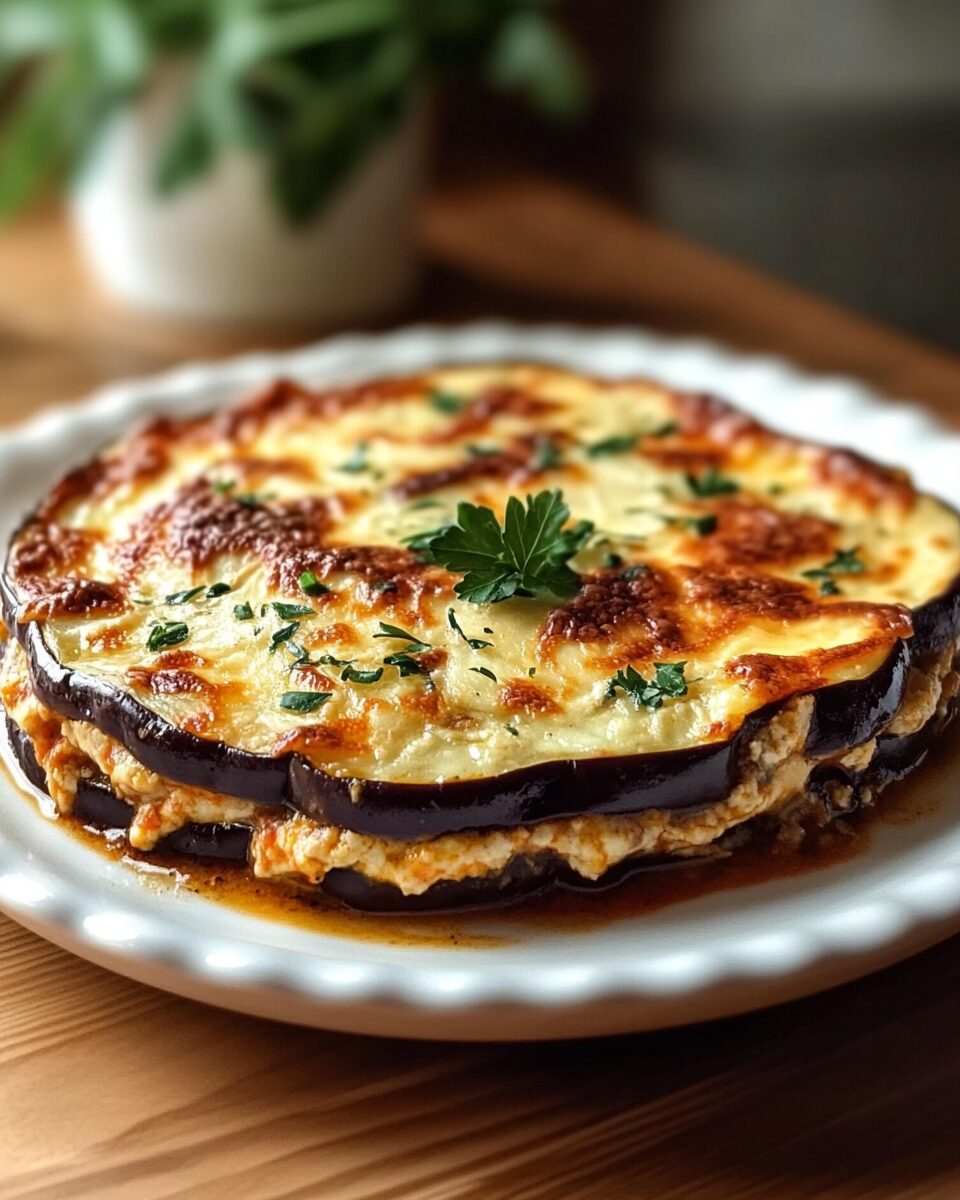This Classic Greek Eggplant Moussaka features tender, roasted eggplants layered with a savory meat sauce and topped with a creamy béchamel sauce. The dish is baked until golden and bubbling, offering the perfect combination of textures and rich flavors.
Perfect for a cozy dinner or a special gathering, this moussaka brings the authentic taste of Greece to your kitchen. It’s an indulgent meal that’s sure to satisfy everyone at the table. The layers of eggplant, meat sauce, and béchamel create a comforting dish that will have your guests asking for seconds.
Full Recipe:
Ingredients:
-
2 medium eggplants, sliced
-
1 lb (450g) ground lamb or beef
-
1 onion, chopped
-
2 garlic cloves, minced
-
1 can (14 oz) crushed tomatoes
-
2 tbsp tomato paste
-
1 tbsp red wine vinegar
-
1 tsp ground cinnamon
-
1 tsp dried oregano
-
1/2 tsp ground allspice
-
Salt and pepper to taste
-
2 tbsp olive oil
-
1/4 cup fresh parsley, chopped
-
1/4 cup grated Parmesan cheese
-
1 cup béchamel sauce (see below for ingredients)
For Béchamel Sauce:
-
2 tbsp butter
-
2 tbsp flour
-
1 1/2 cups milk
-
1/2 tsp nutmeg
-
Salt and pepper to taste
Directions:
-
Preheat your oven to 375°F (190°C).
-
Slice the eggplants and brush them with olive oil. Arrange them on a baking sheet and roast in the oven for about 20 minutes, or until tender and lightly browned.
-
While the eggplants are roasting, heat olive oil in a large pan over medium heat. Add the chopped onion and minced garlic, and sauté for 5 minutes until softened.
-
Add the ground lamb or beef and cook until browned. Stir in the crushed tomatoes, tomato paste, red wine vinegar, cinnamon, oregano, allspice, salt, and pepper. Let the sauce simmer for 15 minutes, stirring occasionally. Remove from heat and stir in fresh parsley.
-
In a separate saucepan, melt the butter for the béchamel sauce. Stir in the flour and cook for 1-2 minutes. Gradually whisk in the milk, cooking until the sauce thickens. Season with nutmeg, salt, and pepper.
-
In a baking dish, layer the roasted eggplants, meat sauce, and béchamel sauce. Repeat layers until the dish is full, finishing with a layer of béchamel sauce on top. Sprinkle with grated Parmesan cheese.
-
Bake for 30-35 minutes, or until the top is golden and bubbling. Let the moussaka rest for 10 minutes before serving.
Prep Time: 20 minutes | Cooking Time: 45 minutes | Total Time: 1 hour 5 minutes
Kcal: 450 kcal | Servings: 6 servings
Classic Greek Eggplant Moussaka: A Timeless Mediterranean Dish
When it comes to Mediterranean cuisine, few dishes are as beloved and iconic as moussaka. Originating from Greece, this rich, comforting dish has traveled across the world, becoming a staple in many households. Moussaka is a layered casserole that features tender eggplants, a hearty meat sauce, and a luxurious béchamel topping, all baked together to create a warm, satisfying meal. Whether served for a family dinner or at a special gathering, this dish brings the flavors of Greece to the table in the most delicious way possible.
The Origins of Moussaka
Moussaka has deep roots in Greek culinary traditions, although its exact origin is debated. The dish itself is thought to have been influenced by various cultures in the Mediterranean and the Middle East. In fact, the name “moussaka” comes from the Arabic word “musaqqa‘a,” which means “chilled” or “moist,” referring to the dish’s characteristic moist texture. While variations of moussaka can be found in countries such as Turkey, Lebanon, and Egypt, the Greek version is perhaps the most famous.
The Greek moussaka, as we know it today, was popularized by famed Greek chef and author, Nikolaos Tselementes, in the 1920s. Tselementes made significant modifications to the traditional recipe, introducing the now-iconic béchamel sauce, which differentiates Greek moussaka from its regional counterparts. The result was a more refined, indulgent version of the dish that combined savory meat sauce, soft eggplants, and creamy béchamel to perfection.
A Flavorful and Nutritious Dish
At its core, moussaka is a simple yet satisfying meal. The main ingredient eggplant is an incredibly versatile vegetable that takes on a tender, silky texture when baked. It pairs beautifully with the rich meat sauce and the creamy béchamel topping. Eggplants are also highly nutritious, offering a good source of fiber, antioxidants, and essential vitamins such as vitamin B6, potassium, and manganese.
The ground meat used in moussaka (often lamb, but beef can be used as well) adds a savory depth of flavor to the dish. The meat sauce, which is typically spiced with aromatic herbs like oregano and cinnamon, is the heart of the dish. These spices not only enhance the taste of the meat but also infuse the entire dish with Mediterranean flavor, giving it an aromatic and comforting quality.
Béchamel sauce, the creamy topping that elevates this dish, is made with butter, flour, milk, and seasonings like nutmeg. It is thick, velvety, and provides a smooth contrast to the other textures in the moussaka. When baked, the béchamel sauce forms a golden crust, adding both flavor and a pleasing visual appeal to the final dish.
Moussaka as a Family Tradition
In Greece, moussaka is often considered a dish for special occasions, family gatherings, or festive celebrations. The preparation of moussaka can be time-consuming, as it requires multiple layers and components to be cooked separately, but it is often prepared with love and shared among family members. It’s a dish that brings people together, providing a satisfying and hearty meal that is perfect for feeding a crowd.
Moussaka has also become a popular dish in Greek restaurants around the world, with many chefs offering their own twists on the classic recipe. Some might add additional vegetables like zucchini or potatoes, while others may opt for a vegetarian version, using lentils or mushrooms in place of meat. Regardless of the variations, the heart of moussaka remains the same layers of tender eggplant, flavorful meat sauce, and a rich béchamel sauce.
How to Make Classic Greek Eggplant Moussaka
While the process of making moussaka can seem daunting, it is a relatively straightforward dish to prepare. The key to a successful moussaka lies in the preparation of the layers. First, the eggplant must be sliced and roasted to bring out its natural sweetness and reduce any excess moisture. This step ensures that the eggplant maintains its structure and doesn’t become soggy during the baking process.
The meat sauce is the next crucial step. It must be simmered for a while to allow the flavors to meld together. The combination of ground meat, tomatoes, spices, and fresh herbs creates a sauce that is hearty and flavorful. Once the sauce is ready, it’s time to assemble the dish by layering the roasted eggplant, meat sauce, and béchamel sauce. The final layer of béchamel should be thick and creamy, ensuring that the top of the moussaka forms a beautiful golden crust as it bakes.
Baking the moussaka takes patience. It should be baked at a moderate temperature for around 30-35 minutes, until the top is golden and bubbling. Once removed from the oven, the dish should rest for a few minutes to allow the flavors to settle and the moussaka to firm up. This makes it easier to cut into neat slices and serve.
Serving and Enjoying Moussaka
Classic Greek Eggplant Moussaka is traditionally served as a main course and pairs wonderfully with a simple Greek salad, fresh crusty bread, and a glass of dry red wine. The rich flavors of the moussaka are balanced beautifully by the crispness of the salad and the lightness of the bread. Moussaka also makes excellent leftovers, as the flavors continue to develop after a day or two.
For those who prefer a lighter meal, moussaka can be served with a side of roasted vegetables or a fresh green vegetable like sautéed spinach or broccoli. While the dish is hearty on its own, a fresh side dish can provide balance and make the meal feel even more satisfying.
Moussaka Variations and Customizations
One of the great things about moussaka is its versatility. While the classic Greek version is beloved by many, there are plenty of variations to explore. For example, you can experiment with different types of meat or even go vegetarian by substituting the meat with lentils, mushrooms, or chickpeas. The use of different spices can also give the dish a unique twist, adding additional depth of flavor.
Some cooks choose to add potatoes to the moussaka, layering them alongside the eggplant for an extra starchy component. Zucchini is another popular vegetable to include, either in place of or alongside the eggplant. Additionally, some people like to top their moussaka with cheese, adding a sprinkle of feta or even mozzarella for extra richness.
For those who follow gluten-free or dairy-free diets, moussaka can be adapted to suit various dietary restrictions. Simply replace the béchamel with a gluten-free or dairy-free alternative, and use a meat substitute if necessary. Many people find that these adjustments don’t compromise the overall flavor of the dish, allowing them to enjoy a traditional recipe with their own dietary needs in mind.
Conclusion:
Classic Greek Eggplant Moussaka is a dish that brings the flavors of Greece right into your kitchen. It’s a comforting, hearty meal that combines tender eggplant, savory meat sauce, and a rich, creamy topping. Whether you’re preparing it for a special occasion, a family gathering, or simply as a comforting meal, moussaka is sure to impress.
With its delicious layers and rich flavors, moussaka has earned its place as one of the most iconic Mediterranean dishes. It’s a perfect example of how simple ingredients, when prepared with care and attention, can come together to create something extraordinary. The dish’s versatility also means that it can be adapted to suit various tastes and dietary preferences, making it a timeless favorite for all.

